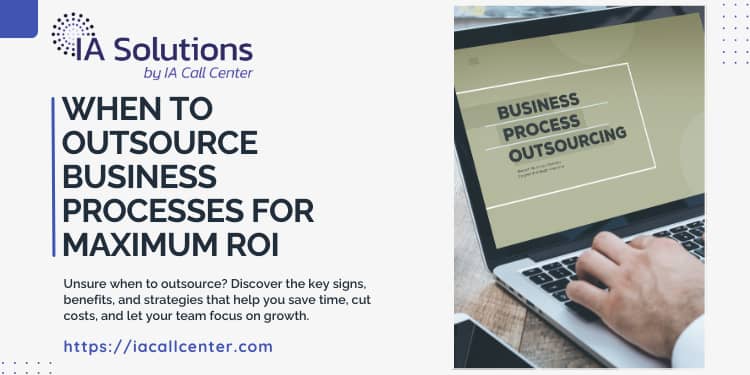Thinking about farming out some of your company’s work? It’s a big decision, and knowing when to outsource business processes can really make a difference in how well your company does. It’s not just about saving a buck, though that’s often part of it. It’s about working smarter, getting things done faster, and freeing up your own team to focus on the stuff that really matters. We’ll look at the signs that tell you it’s time to bring in outside help and how to make sure you’re getting the most bang for your buck.

Key Takeaways
- When your business needs specialized skills that your current team doesn’t have, or when deadlines are consistently being missed due to workload, it’s a strong signal that outsourcing might be the answer. This allows you to access expertise and extra capacity without the commitment of hiring.
- Outsourcing can be a smart move when specific business functions become too expensive to manage in-house, such as specialized IT services or customer support. It offers a more cost-effective way to get the job done, especially when dealing with high costs or needing to scale quickly.
- To get the best results from outsourcing, it’s important to set clear goals for what you want to achieve, carefully choose the right partner who fits your business needs, and invest time in onboarding and communication. This ensures the outsourced work aligns with your company’s objectives and quality standards.
Understanding When to Outsource Business Processes for Growth

So, you’re thinking about whether it’s the right time to outsource some of your business processes? It’s a big decision, and honestly, it’s not just about cutting costs, though that’s definitely a perk. It’s really about making your company stronger and setting it up for future success.
Think about it this way: are you spending way too much time on tasks that don’t directly bring in money or help you grow? Things like sorting through mountains of paperwork, handling basic customer questions, or managing your social media when you’d rather be strategizing your next big move. If that sounds familiar, it’s a pretty clear signal that it might be time to let someone else handle those non-core jobs. This frees you and your team up to focus on the stuff that really matters – like developing new products, finding new clients, or figuring out how to make your main service even better. It’s about getting more done without just hiring a bunch of new people, which can get expensive fast.
Here are a few common signs that outsourcing could be a smart move:
- Your team is swamped: If deadlines are constantly being pushed back and people are burning out, you probably need more hands on deck. Outsourcing can provide that extra capacity quickly.
- You need skills you don’t have: Maybe you need a super-specialized IT person or a marketing guru, but hiring one full-time just doesn’t make sense for your budget or needs right now. Outsourcing gives you access to that talent on demand.
- Costs are getting out of control: If handling a task in-house drains too many resources compared to an external provider, it may be time to consider outsourcing. For example, setting up a 24/7 customer support line can be incredibly expensive locally, but a dedicated contact center can offer that service for much less.
- You’re planning to expand: Whether it’s launching a new product line or looking at international markets, outsourcing can provide the infrastructure and support you need to scale up without a massive upfront investment.
When you outsource, you’re not just offloading work; you’re strategically investing in your company’s ability to grow and adapt. It’s about making smart choices now so you can achieve bigger goals later. The real return on investment comes when those cost savings are put back into business growth.
Ultimately, deciding to outsource business processes is about being smart with your resources. It’s about recognizing what you do best and letting others handle the rest, so your business can truly flourish.
Key Indicators of When to Outsource and Leverage Outsourcing Services
Sometimes, you just know it’s time to bring in outside help. It’s not about admitting defeat; it’s about being smart with your resources. One big sign is when your team is spending way too much time on tasks that don’t directly make you money. Think about all those hours spent on paperwork, scheduling, or basic customer inquiries. If these non-core activities are eating up your team’s day, it’s a clear signal that you might benefit from outsourcing services.
Another indicator is when demand suddenly spikes, and your current staff just can’t keep up. Maybe you landed a big client, or a seasonal rush hit harder than expected. Instead of burning out your existing employees or missing opportunities, bringing in an external team can provide the extra hands you need. This is especially true if training new people internally would take too long or be too costly.

Here are some common situations where outsourcing makes sense:
- Overwhelmed by Non-Core Tasks: Your team is bogged down with administrative duties, data entry, or basic customer support, taking focus away from revenue-generating activities.
- Sudden Increase in Workload: You’re experiencing a surge in demand that your current staff can’t handle without sacrificing quality or missing deadlines.
- Need for Specialized Skills: Your business requires specific technical or creative skills that you don’t have in-house, and hiring full-time specialists is not feasible.
- Cost Reduction Goals: You’ve identified certain functions that are significantly more expensive to manage internally than they would be through an external provider.
- Desire for Greater Flexibility: The ability to rapidly scale operations to match market changes or project needs is essential for staying competitive.
When you find yourself consistently missing deadlines or struggling to meet customer expectations due to capacity issues, it’s a strong signal that your current operational model might not be sustainable for growth. Outsourcing can provide the necessary bandwidth and efficiency to get back on track and maintain a high level of service.
At its core, identifying these signs is the starting point. It’s about identifying where your internal resources are being stretched too thin or where external partners can bring more value, allowing you to concentrate on what truly drives your business forward.
When to Outsource: Essential Steps in the Outsource Process
So, you’ve decided outsourcing is the way to go. That’s great! But how do you actually do it without a hitch? It’s not just about picking a company and handing over tasks. There are definite steps to follow to make sure it works well and actually helps your business.
First off, you really need to figure out what you want to outsource. Don’t just guess. Look at your business and see which parts are taking up too much time or aren’t really your strong suit. Maybe it’s customer service, or perhaps it’s something like accounting. Identifying these non-core functions is key.
Once you know what you’re outsourcing, you have to get your own house in order. This means documenting your current processes. Think of it like writing down how you do things so the new team knows exactly what’s expected. This helps avoid confusion later on.
Here are some of the main outsource process steps:
- Define Clear Objectives: What do you want to achieve by outsourcing? Is it cost savings, better quality, or faster turnaround? Setting specific goals, like measurable benchmarks, is super important. This helps you know if the outsourcing is actually working.
- Select the Right Partner: This is a big one. Do your homework. Look for companies that have experience in the specific area you need help with. Check their track record and see if they seem like a good fit for your company culture. Finding a good partner is critical to maximizing your ROI.
- Prepare Your Systems: Make sure your internal systems can talk to your new partner’s systems. This might involve updating software or setting up new communication channels. Good collaboration tools are a must.
- Onboard and Train: Don’t just throw them into the deep end. Give your new outsourcing team the information and training they need to succeed. This includes explaining your business goals and any specific procedures.
- Establish Communication and Oversight: Set up regular check-ins and reporting. How will you monitor their performance? Clear communication and progress tracking ensure everyone stays aligned.
It’s also a good idea to think about the tools and software you’ll both be using. Selecting wisely makes all the difference in ensuring smooth operations. You want things that are secure, easy to use, and can connect with what you already have. This helps keep your data safe and makes collaboration much easier.
Finally, remember that outsourcing is an ongoing relationship. You’ll need to keep an eye on performance and be ready to make adjustments. By following these steps, you can set yourself up for a successful outsourcing partnership that really helps your business grow. If you’re looking to improve your sales process, consider outsourcing sales to a specialized team.
Evaluating the Benefits of Outsourcing and Knowing When to Outsource
So, you’re thinking about outsourcing some of your business tasks. It’s a big decision, and honestly, it makes sense to really look at what you stand to gain. The main idea behind outsourcing is to get things done more efficiently and often, for less money. Think about those tasks that eat up your time but don’t directly bring in sales or create your main product. Things like customer service, data entry, or even some marketing tasks can be handed off.

The biggest advantage is freeing up your internal team to focus on what they do best. When you’re not bogged down with administrative work, you can actually spend more time on growing your business, innovating, or building stronger relationships with your clients. It’s like having an extra set of hands, but these hands come with specialized skills you might not have in-house.
Here are some common situations where outsourcing really shines:
- Spending too much time on non-core functions: If you’re spending hours on tasks that aren’t your main business, like bookkeeping or managing social media, it’s a clear sign. Outsourcing these can give you back valuable time.
- Increased demand requires additional capacity: When your business suddenly gets busier, and your current staff can’t keep up, outsourcing can quickly provide the extra help you need without the hassle of hiring and training new people.
- When what you need is too expensive: Sometimes, hiring specialists for certain jobs, like advanced IT support or graphic design, is just too costly to do in-house. Outsourcing can give you access to that talent at a much lower price point.
Outsourcing isn’t just about cutting costs; it’s about smart resource allocation. Working with external providers gives you access to specialized skills and advanced technologies without the high cost of building them in-house. This shift allows your team to prioritize strategic work that sparks innovation and boosts competitiveness.
When you look at the numbers, companies often see significant cost savings, sometimes between 15% to 40%, depending on what they’re outsourcing and where the provider is located. Plus, these external teams usually have established processes, meaning they can often complete tasks faster and with fewer mistakes. This improved efficiency can really make a difference in your overall productivity and customer satisfaction. It’s about getting more done, better, and often for less. If you’re looking to streamline operations and boost your customer experience, considering an omnichannel approach can be a smart move, providing a unified view of customer interactions across all touchpoints. Learn about omnichannel
When to Outsource: Choosing the Right Outsourcing Solutions for Maximum ROI
Picking the right outsourcing solutions is more than just finding the cheapest option; It comes down to choosing a partner that aligns with your business needs and goals. Think about what you want to achieve. Are you looking to cut costs, get access to specialized skills, or maybe speed up how quickly you get things done? Your choice of provider should directly support these objectives.
Here are some things to consider when selecting your outsourcing partner:
- Expertise and Skills: Does the provider have proven experience in the specific area you need help with? Look for case studies or examples of their work.
- Cultural Fit and Communication: How well do they understand your business culture? Good communication is key, especially if you’re working across different time zones or languages.
- Scalability and Flexibility: Can they grow with your business? Your needs might change, so a partner who can adapt is important.
- Reliability and Track Record: What do other clients say about them? A solid history of success is a good sign.

Customizing your agreement with your chosen provider is vital for getting the best return. This means clearly defining expectations, setting measurable goals (like Key Performance Indicators or KPIs), and outlining each party’s responsibilities.
Setting clear objectives in your contract helps both you and your service provider stay on the same page. It makes it easier to track progress and see if the outsourcing is actually helping you meet your business aims, like reducing costs or improving service quality. Without these clear targets, it’s hard to know if you’re getting your money’s worth.
Don’t forget to regularly check in on how the partnership is going. Continuous improvement means looking at what’s working and what’s not, and making adjustments. This ongoing management helps you make sure your outsourcing solutions keep providing the best possible results for your company.
Figuring out when to outsource can be tricky, but it’s key to getting the most bang for your buck. Think about what tasks take up too much of your team’s time or require special skills you don’t have in-house. Making smart outsourcing choices can really help your business grow and save money. Want to learn more about finding the best fit for your company? Check out our website today and discover the solutions built for your business!
Wrapping It Up: Outsourcing for Smarter Growth
So, when all is said and done, deciding to outsource isn’t just about cutting costs, though that’s a big part of it. It’s really about making your business work better. Think about it – if you’re spending too much time on tasks that don’t directly bring in money, or if your team is swamped and can’t keep up, outsourcing can be a lifesaver. It gives you access to people who are really good at specific jobs, whether that’s customer service, IT, or even marketing. Plus, it lets you scale up or down pretty easily, which is super handy when things get busy or slow. The key is to pick the right partner, set clear goals, and keep the lines of communication open. When you get it right, outsourcing can free you up to focus on what you do best, helping your business grow without all the extra headaches.
Frequently Asked Questions
When is the best time for a business to start outsourcing tasks?
It’s a good idea to think about outsourcing when your team is spending too much time on tasks that don’t directly make money, like paperwork or answering basic customer questions. When growth outpaces your current staff, outsourcing provides the support you need without the cost of building a large in-house team.
What are the main benefits of outsourcing for a company?
Outsourcing can help businesses save money because they don’t have to pay for extra office space, equipment, or training for new employees. It also gives them access to experts who are really good at specific jobs, like marketing or customer service. Plus, it makes businesses more flexible, allowing them to easily handle more work when needed or scale back if things slow down.
How can a business make sure outsourcing is successful and leads to a good return on investment?
To get the most out of outsourcing, businesses should first be very clear about what they want to achieve, like saving money or improving customer service. Then, they need to carefully pick the right partner who understands their goals and has a good track record. Keeping communication open and setting clear expectations with the outsourcing team is also super important for success.












